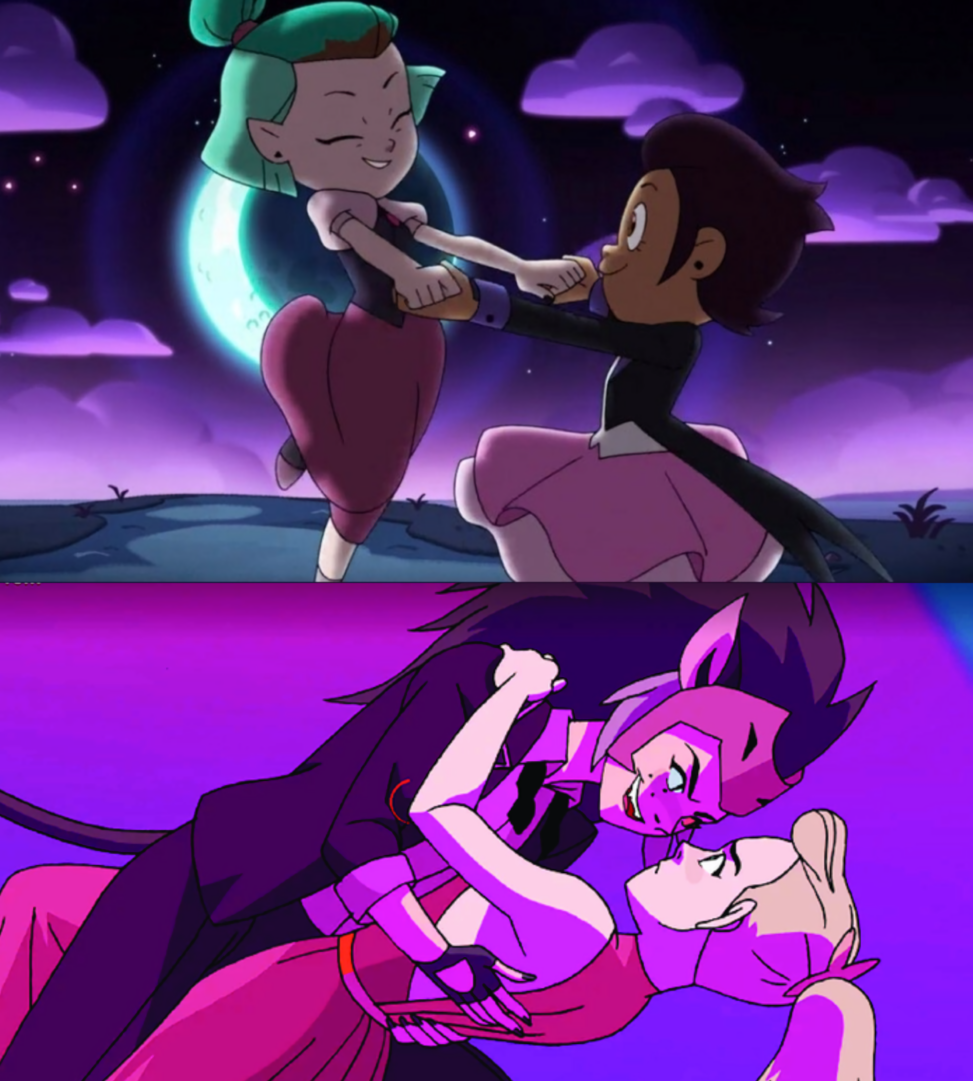Word count:796
Bri N
Queer Representation In Media: She-Ra VS The Owl House
Queer characters are being shown more and more in kids’ media, something that is still not easy for writers to get approved for. Due to the reactions of homophobic groups, there are often many attempts to prevent or stop queer characters from appearing in media. How these characters shown on screen have been changing and adapting to show better representation on screen. In this paper I will be reviewing the evolution of queer characters through She Ra Princesses of Power (2018-2020)’s She-Ra and Catra, and The Owl house (2020-2022)’s Luz and Amity. Both these queer couples share a numerous amount of traits and tropes. Both are enemies to lovers. Both Luz and Catra are people of color. Both Luz and Catra are read as more masculine compared to their feminine girlfriends
Enemies To Lovers And Redemption Failure
In The Owl House Amity starts off as an antagonist starting off as a school bully to Luz’s friend Willow. Amity starts off by making fun of Willow for not being able to use abomination magic. Luz helps Willow fake a grade, causing Amity to lose her status as top student and her to view both Willow and Luz as her enemies. Amity begins her redemption arc in the same season. Luz and Amity are seen to not get along when they first meet, over time Luz learns more about Amity and works on befriending her. Although Amity becomes friends with Luz and Willow, it is not until the final Season that Amity has a proper good relationship with Willow.
In She-Ra Catra and Adora have a heavy enemies to lover’s trope. The two both start off on the same side of a war under the watch of their abusive mother figure. Throughout the show, Catra stays with the oppressing side of the war while Adora switches to the good side. Catra views Adora’s betrayal of the Horde as a personal attack and throughout the show fights against Adora, occasionally using too much force as well as blaming and attempting to make Adora feel like Catra’s aggression is her fault. Catra does not start her redemption arc until the 3rd episode of the final season in which she is quickly forgiven by Adora as Adora states she never hated Catra.
Villains in kids’ movies have been queer coded for years, having Catra play such a huge role as an antagonist may have been interesting for the story, but it also plays on the old stereotype that queer people must be bad. Furthermore, unlike Amity’s quick redemption arc, Catra’s was one that should not have been made so quickly, especially with everything she had done during the war. Amity’s redemption arc fitted her character as she was a very minor antagonist, and she never truly meant to cause harm while Catra fully knew what she was doing and was shown to enjoy it.
Representation of Culture
Luz was written to be Hispanic, this is made very clear in the series, Luz’s mother in the first episode speaks to her in spanish and shortly after Luz and Amity start dating Amity starts learning bits of spanish and while trying to learn how to call Luz a pet name in spanish call’s Luz a sweet potato by mistake.
Catra was meant to be Latina however the writer didn’t commit to writing her that way, so she does not show any connection to any culture. The only clue the audience is given is her character design meaning the fans are free to interrupt her as they’d like.
Couple Screen Time
Disney is known to push queer characters to the background while trying still show that they have queer characters, despite this when Dana Terrace came with the idea of The Owl House, she refused to change her character and was able to get her queer character on screen. Amity and Luz were implied in season one and part way through Season 2 were able to get together leaving plenty of time to explore and display a healthy queer couple on screen.
She-Ra was a different story, Catra and Adora had to have deniability in the show which meant their romance would be kept in the background. The two only get together in the final episode, leaving no time to show that their relationship would have actually been like.
Overall, Amity and Luz hold more screen time as a couple in their show and display a much healthier dynamic as well as not shying away from displaying bits of Luz’s culture in the show. She-Ra was a part of the shows that lead to more queer media, and when it came out it helped bring more light to the idea of queer kids shows, The Owl House just was able to shine more.
References
Cummings, Kelsey. 2022. “Queer Seriality, Streaming Television, and She-Ra and the Princesses of Power”, Global Storytelling: Journal of Digital and Moving Images. doi: https://doi.org/10.3998/gs.1547
Farnworth, Ashlyn. 2024. “LGBTQ+ Representation in Children’s Television Programming”, California State University. https://scholarworks.calstate.edu/downloads/z029pc34z
Kotlánová, Adéla. 2024. “Evolution of Representation of Lesbian Characters in Children’s Animated Media”, Masaryk University. https://is.muni.cz/th/w9vqv/Kotlanova_BA_Thesis_-_Lesbian_Representation.pdf
O’Brien, Katelyn. 2024. “Queer Kids are Not Alone: Searching for 2S-LGBTQIA+ Representation in Children’s Animated Television”, Toronto Metropolitan University. doi. https://doi.org/10.32920/25164542.v1
Philbrook, Ashlyn. Hemmer, Emily. 2024. “Seeing Ourselves: The Impact of Queer Representation in Children’s Media”, https://hokieswrite.com/wp-content/uploads/2024/06/1106-Philbrook-P3SustainedResearchProject-SP24.pdf
Steveson, ND. 2020. X. https://x.com/Gingerhazing/status/1276609836403159040
Terrace, Dana. 2020. “The Owl House”, Disney.
Stevenson, ND. 2018. “She-Ra and the Princesses of Power”, Dreamworks.


chown20
Hi Bri, your comparison of She-Ra and the Princess of Power and The Owl House offers a very good overview of how both stories depict queer relationships. The analysis does a great job of highlighting the similarities between the main couples, She-Ra/Catra and Luz/Amity, pointing out the shared “enemies to lovers” trope and the representation of more masculine characters paired with female counterparts. Additionally, the contrast between the redemption arcs of Amity and Catra and critiquing the sudden shift towards redemption and the implications of her portrayal as an antagonist. The note of the cultural background, with The Owl House showcasing Luz’s Hispanic heritage, whereas She-Ra leaves Catra’s Latina identity underdeveloped. Finally, they compare screen time and character development, emphasizing that Luz and Amity’s relationship had more time and space to flourish than Catra and Adora’s. Your main points are well-organized, they analyze the narrative role of each couple, address redemption arcs and queer-coded villains, and explore cultural representation and the extent of relationship portrayal on screen. While the critique is strong in its thematic analysis, it lacks scholarly sources to support observations on queer representation, media censorship, or historical queer coding in children’s media, which would have added academic depth. The comparative analysis highlights key similarities and differences effectively, but mentioning the broader impact of these series on the landscape of children’s media would have offered a more comprehensive context. Overall, your analysis captures the core narrative elements of both shows but could be improved with deeper research references and a discussion of larger implications on media trends.